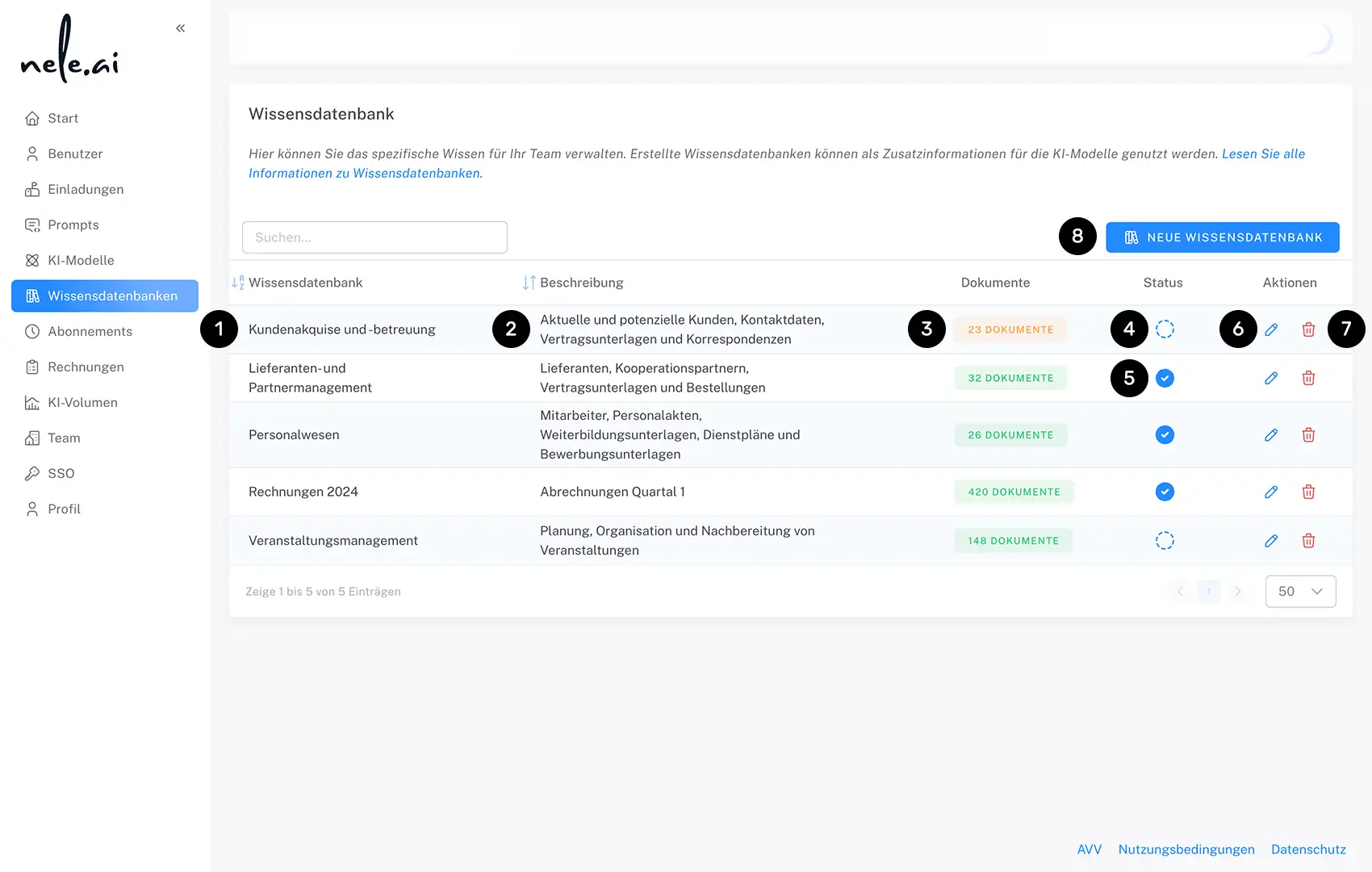Knowledge databases to expand the knowledge horizon
Upload documents and content from websites here to expand the knowledge base of your AI model and manage the specific knowledge for your team. Created knowledge databases can be used as additional information for the AI models. The data volume of knowledge databases is limited to a maximum of 2 GB for companies. Each document must not exceed 20 MB in size.
Feature overview
Knowledge base overview

If you have already created a knowledge base, you can enter the assigned title here (1), the description (2) and view the number of integrated documents (3).
The color of the document number note shows you whether all integrated documents are also actively assigned to users (the note is green) or whether individual documents in the database are still marked as drafts (the note is orange). If no documents have been added to the knowledge base yet, the message is red.
With one click on the note about the number of documents (3) You get to the document overview.
In the “Status” column, you can activate and deactivate a knowledge database by clicking on the checkbox (4). When activating, you can decide whether you want to make the database available exclusively to your team (= “publish”) or assign it directly to users. A published and simultaneously assigned database is marked by a blue icon (5). A model that has only been published and is not yet assigned to any users is marked with an orange icon.
You can also edit knowledge bases (6) and delete (7).
To create a new knowledge base, click on the “New Knowledge Base” button (8).
Creating a knowledge base
Start by giving your knowledge base a title (1) and a description (1a).
Next, determine which AI model (1b) the database should be based.
Finally, you decide whether the knowledge database should only be published, i.e. made available to the team, or should also already be assigned to all users (1c).
Confirm your entries with “Save” or cancel the process with “Cancel” (2). After you click Save, you will be taken to the area where you can upload documents.
After you click Save, you will be taken to the area where you can upload documents (3). The currently supported file types can be found in the list shown there.

Manage and add documents

In the knowledge base overview, click on the number of documents in the “Documents” column (3, see Knowledgebase overview“)to access the document overview.
With the search function (1) You can quickly and easily find documents or website URLs that have already been integrated. When you enter a search term, only the entries that match your search are displayed.
Below, you can see both the website URLs integrated in the knowledge database listed in a table (2) as well as integrated documents (3).
You will also be shown the status of an entry (e.g. “Draft” or “Provided”) (4) and shows the date of the last change (5). You can delete an entry under “Actions” (6).
If you want to make all documents available to your team, click on the “Provide all” button (7).
Add a document or a website URL using the “Add documents” button (8) add.
Include a website URL

If you decide to include a website URL, you will be redirected to a corresponding area.
First enter the URL of the page that you want to include in the “Website” input field and confirm with the plus icon or the enter key (1). If you want to include multiple URLs at the same time, separate them with spaces.
Note that on a website, the specific website area of the URL, such as exclusively the start page or only a subpage, is read out and not the entire Internet presence.
If it is a public website with no access restrictions, leave the authentication alone (2) on “None.”
If this is a password-protected page, select “Basic” (3) and enter the appropriate values in the “Username” and “Password” fields.
Use the bearer authentication method, enter “bearer” and the corresponding bearer token here (4).
If your website uses another type of authentication, you can enter it under the “Custom” option (5).
Finally, confirm using the “Add” button or cancel the process via “Cancel” (6). The “Status” column on the document overview shows you the status of the document or URL upload after a short waiting period. It can then be published and/or assigned to users.






